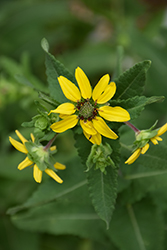It's all about ...
plants

Height: 24 inches
Spread: 24 inches
Sunlight:
![]()
Hardiness Zone: 7a
Other Names: Texas Greeneyes
Description:
This selection produces attractive yellow, daisy like flowers all summer, on plants that can thrive in tough garden conditions; cold hardy and drought resistant
Ornamental Features
Texas Green Eyes features dainty corymbs of yellow daisy flowers with dark red eyes and green bracts at the ends of the stems from late spring to late summer. The flowers are excellent for cutting. Its serrated pointy leaves remain forest green in colour throughout the season. The purple stems can be quite attractive.
Landscape Attributes
Texas Green Eyes is an herbaceous perennial with a mounded form. Its medium texture blends into the garden, but can always be balanced by a couple of finer or coarser plants for an effective composition.
This is a relatively low maintenance plant, and is best cleaned up in early spring before it resumes active growth for the season. It is a good choice for attracting birds, bees and butterflies to your yard, but is not particularly attractive to deer who tend to leave it alone in favor of tastier treats. Gardeners should be aware of the following characteristic(s) that may warrant special consideration;
- Self-Seeding
Texas Green Eyes is recommended for the following landscape applications;
- Mass Planting
- Rock/Alpine Gardens
- General Garden Use
- Naturalizing And Woodland Gardens
Planting & Growing
Texas Green Eyes will grow to be about 24 inches tall at maturity, with a spread of 24 inches. Its foliage tends to remain dense right to the ground, not requiring facer plants in front. It grows at a slow rate, and under ideal conditions can be expected to live for approximately 10 years. As an herbaceous perennial, this plant will usually die back to the crown each winter, and will regrow from the base each spring. Be careful not to disturb the crown in late winter when it may not be readily seen!
This plant should only be grown in full sunlight. It prefers dry to average moisture levels with very well-drained soil, and will often die in standing water. It is considered to be drought-tolerant, and thus makes an ideal choice for a low-water garden or xeriscape application. It is not particular as to soil pH, but grows best in sandy soils. It is somewhat tolerant of urban pollution. This species is native to parts of North America..
This plant is not reliably hardy in our region, and certain restrictions may apply; contact the store for more information.
